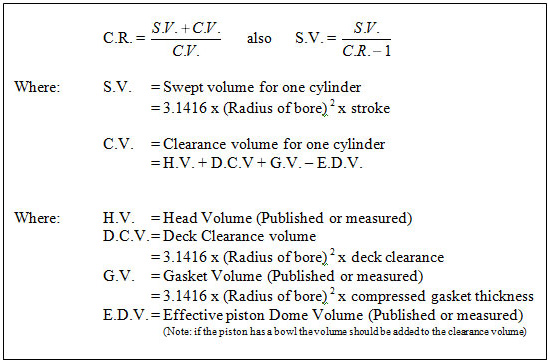COMPRESSION RATIOS AND PERFORMANCE CAMSHAFTS
Some years ago when I was in the United States I was lucky enough to spend some time with master engine builder David Vizard. He passed on some useful tips regarding the compression ratio selection for naturally aspirated competition engines. Often those less experienced in the performance engine building field overlook matching the compression ratio correctly to the cam profile. First we better look at how to calculate the compression ratio (C.R.) in a cylinder.
The calculation on an engine’s compression ratio (C.R.) is based on the formula:

Since a long duration cam does not close the intake valve until the piston is much further up the bore, it is necessary to utilise a higher compression ratio, as at low rpm the cylinder will suffer from reverse flow and poor cylinder filling. In other words, the cylinder may have filled only 75 percent of the total swept volume of the cylinder. This means that the effective or dynamic compression ratio will be far less then than the actual calculated or static compression ratio.
One of David Vizard’s observations was that all engines operate between 8.3 and 9 to 1 dynamic compression ratio depending on type of fuel used. This seems contradictory to the high compressions used in performance vehicles, but this compression ratio is not calculated on the total swept volume of the cylinder, but on the volume left above the piston when the intake valve closes. 9.0 to 1 dynamic compression ratio is the upper limit when using high octane racing gasoline and when New Zealand 96 pump gas is utilised the 8.3 to 1 ratio should not be exceeded.
I would like to put this theory into an example. Now let us assume that the engine we are building is typical 350 Chevrolet smallblock with .030” over bore to give us 727 cc swept volume in one cylinder. I will give 3 choices of cam profiles and match the compression ratio to each of these applications. The 3 camshaft profiles will be Auckland Cams with 270, 280 and 290 degrees measured duration. All other factors being equal, the engine is assembled using these 3 profiles and, with the help of an accurate degree wheel, the valve closure points are measured accurately and noted against the cam profile. This can also be calculated, but more easily measured during the engine build. To start any calculations we need a combustion or clearance volume (C.V.). We will fix this at 80.7 cc, as this will give us a static compression ratio of 10 to 1.

As the cam profile increases in duration the intake valve will close later in the cycle and therefore not trapping as much air. The 270 cam trapped 81% of its volume or 589cc. This calculates to 8.3 to 1 dynamic compression ratio and therefore would be the optimum (and maximum) ratio when used on 96-pump gas without encountering detonation. The 280 cam profile however managed to trap 78.1% or 568cc. This relates to an 8.04 to 1 dynamic compression ratio. The 290 cam only trapped 74.2 percent of the charge, which yields 539cc and this produces a dynamic compression ratio of 7.68 to 1. As you can see the engine is rapidly losing dynamic compression and this heavily influences the large cams to drop off rapidly at low rpm and fail to deliver their power potential. To calculate the correct static compression ratio let us assume that this engine is to be street driven, and therefore the engine need to run on pump 96 octane gasoline and no more than 8.3 to 1 dynamic compression ratio.

These combustion or clearance volumes are required with each cam profile to reach the appropriate dynamic compression ratio.
Finally I would like to show how this influences the static compression ratio. The 270-cam profile should measure a 10 to 1 static compression ratio, and the 280 cam should dial in at 10.34 to 1. The 290 cam however should have 10.85 to 1 static compression ratio to offset the late intake valve closure. In more radical cam-profiles static compression ratios of 12 to 1 and higher are not uncommon.
Note: The above mentioned recommended dynamic compression ratios are guidelines for natural aspirated applications under normal combustion conditions. The engine should not draw in unduly heated intake air, run at excessively high temperatures or suffer from incorrect ignition timing, as this will limit the compression ratio used with a given octane of fuel. These calculations can be used on any naturally aspirated engine.
If you have any queries or problems on calculating the compression ratio on your particular engine drop me a line or use our online enquriy form
